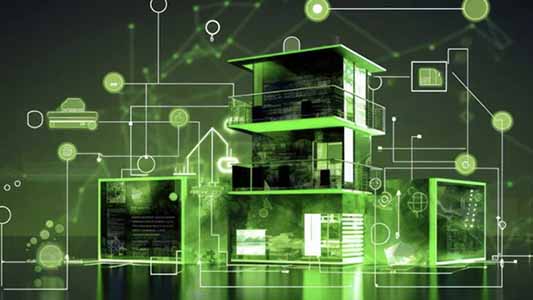The Internet of Things (IoT) has played a pivotal role in making homes, cars, and a wide of range of devices smarter—hence, the smart home, smart car, smartphone, and more. Continued advancements in IoT are also making these same things greener by enhancing energy efficiency. We can think of this concept as Green IoT, which utilizes IoT capabilities to optimize smart home energy consumption through a multi-pronged approach. Parts of this approach include employing advanced thermostats that utilize mesh networked sensors for more precise heating and cooling control, implementing weather-monitoring irrigation systems powered by renewable energy sources to maximize lawn and garden watering, and fine-tuning electric vehicle (EV) charging schedules to minimize peak-hour energy consumption.

Green IoT encompasses a diverse array of applications with far-reaching implications for smart homes. These applications, in turn, have the potential to influence multiple factors that affect both the energy industry and consumer behavior. In the following sections, we will delve into the impacts and numerous benefits associated with the seamless integration of Green IoT technology into smart homes.
The Green IoT Effect

Among the most profound implications for smart homes will be the progress made by hardware technologies. Artificial intelligence algorithms, self-powered or self-sustaining sensors, and intelligent sleep modes are just a few of the advances to watch for that will make Green IoT even more powerful and wide-ranging than it already is. Let’s look further into how Green IoT will affect the future of the smart home.
Data Growth as Currency
Data already fuels insights in a variety of industrial sectors. Using IoT sensors, homeowners can access their own insights to understand their energy and water consumption habits, optimize use, and even feed energy back into the grid from renewable sources. Continuous data growth, a key strategy element in decreasing carbon footprint, is one of the many implications of Green IoT.
Control for Consumers

Data from smart technologies—ranging from HVAC systems to cameras to appliances, watering systems, and furnaces—will likely feed into a central management platform for consumers. Through apps, consumers gain control by having greater transparency into their energy usage and enjoy more convenience. For example, dialing the heat up remotely just before returning home is an easy comfort and a bonus of Green IoT.
Consumer-Focused Regulations
With the increasing use of data to fuel smart homes comes more regulations for IoT overall. Data privacy regulations like the European Union’s General Data Protection Regulation (GDPR) help consumers access information about how their data is used and stored. With sensors regulating smart homes, cybersecurity regulations and standards must also be updated to decrease data breaches. Governments can also boost the adoption of smart home technologies through rebating methods that promote efficiency and save energy. Such regulations could take the form of rebates for installing solar panels that connect to the smart grid or switching to induction ovens that decrease the home’s overall carbon footprint. Net metering policies will also help homeowners monitor their energy consumption and help sell energy back to the grid.
Technological Advances
One of the most significant implications for Green IoT and the smart home is in the field of technology. IoT has already seen significant progress, but we expect to see further breakthroughs with a more direct impact on the smart home. Numerous areas are being actively researched and present great potential for energy efficiency.
Net Zero Energy Consumption

One of the early significant challenges for IoT has been the energy requirements of the many sensors. How often do batteries need to be changed? Who should be responsible for these tasks? Self-charging sensors are a game-changer because they derive power from solar circuits or kinetic energy and can store and use the harvested energy as needed. Photovoltaic cells and piezoelectrics for harvesting solar and kinetic energy, respectively, can add to sensors’ value. Designers will need to factor in added bulk from the hardware components required for these energy storage systems. However, a smart home with self-charging sensors will not need owners to change batteries and disrupt performance.
Routing Procedures for Load Sharing
Information from hundreds, if not tens of thousands, of sensors can strain networks, but dynamic traffic rerouting can help optimize load. While data from a single smart home alone might not be cause for concern, the increasing application of Green IoT to entire cities makes this technology an important one to watch.
Artificial Intelligence Applications

Data from smart homes can feed AI algorithms that can fine-tune and optimize practically every aspect of energy consumption. Equally important, predictive analytics can forecast parts failures, so repairs can be made proactively to keep the smart home functioning without disruptions.
Intelligent Sleep Modes

Sensors being able to lie low when not in active use and consume only a fraction of energy will help prolong the life of Green IoT devices. Extended periods of no activity can also kickstart “deep sleep” mode, further improving efficiency.
Remote Wireless Charging
The possibility of charging devices, IoT or otherwise, remotely and without wires is a developing area with significant implications for Green IoT and the smart home. Of particular interest is long-distance charging, which relies on the principles of magnetic resonance to do the job.
Conclusion
The drive to decrease energy consumption is fueling adoption of Green IoT technology across a range of sectors. While the journey ahead promises exciting technological advancements, the immediate benefits are already palpable: enhanced energy efficiency, greater user control, and an undeniable reduction in our carbon footprint. As we embrace Green IoT in our homes, we invest in a more imaginative living space and a sustainable future for generations to come. It’s not just about smart homes anymore; it’s about intelligent living.












